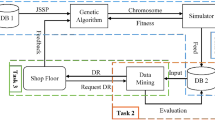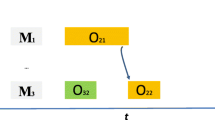Abstract
Dispatching rules are commonly used for job shop scheduling in industries because they are easy to implement, and they yield reasonable solutions within a very short computational time. Many dispatching rules have been developed but they can only perform well in specific scenarios. This is because a dispatching rule or a combination of dispatching rules always pursues a single or multiple fixed production objectives. A lot of approaches (e.g. simulation based or machine learning based approaches) have been published in the literatures attempted to solve the problem of selecting the proper dispatching rules for a given production objective. To select a combination of dispatching rules per randomly selected combination of objectives, this paper investigates a novel semantics-based dispatching rule selection system. Each of the dispatching rules and production objectives relates to a set of scheduling parameters like processing time, remaining work, total work, due date, release date, tardiness, etc. These parameters are semantically interrelated so that a dispatching rule and a production objective can also be semantically related through their semantic expressions. A semantic similarity value can be calculated by comparing their semantic expressions. Based on this idea, a semantics-based dispatching rule selection system for job shop scheduling is developed to generate a combination of dispatching rules given randomly selected combination of production objectives. A proof-of-concept verification process is provided at the end of the paper.











Similar content being viewed by others
References
Ahmed, F., & Han, S. (2015). Interoperability of product and manufacturing information using ontology. Concurrent Engineering, 23(3), 265–278.
Azadeh, A., Hosseini, N., Abdolhossein Zadeh, S., & Jalalvand, F. (2015). A hybrid computer simulation-adaptive neuro-fuzzy inference system algorithm for optimization of dispatching rule selection in job shop scheduling problems under uncertainty. The International Journal of Advanced Manufacturing Technology, 79(1), 135–145.
Azadeh, A., Negahban, A., & Moghaddam, M. (2012). A hybrid computer simulation-artificial neural network algorithm for optimisation of dispatching rule selection in stochastic job shop scheduling problems. International Journal of Production Research, 50(2), 551–566.
Baykasoglu, A., Göçken, M., & Özbakir, L. (2010). Genetic programming based data mining approach to dispatching rule selection in a simulated job shop. Simulation, 86(12), 715–728.
Blackstone, J. H., Phillips, D. T., & Hogg, G. L. (1982). A state-of-the-art survey of dispatching rules for manufacturing job shop operations. International Journal of Production Research, 20(1), 27–45.
Borgo, S., & Leitão, P. (2004). The role of foundational ontologies in manufacturing domain applications. In R. Meersman & Z. Tari (Eds.), On the move to meaningful internet systems 2004: CoopIS, DOA, and ODBASE. OTM 2004. Lecture notes in computer science (Vol. 3290). Berlin: Springer.
Borsato, M. (2014). Bridging the gap between product lifecycle management and sustainability in manufacturing through ontology building. Computers in Industry, 65(2), 258–269.
Canbolat, Y. B., & Gundogar, E. (2004). Fuzzy priority rule for job shop scheduling. Journal of Intelligent Manufacturing, 15, 527–533.
Chang, X., Rai, R., & Terpenny, J. (2010). Development and utilization of ontologies in design for manufacturing. Journal of Mechanical Design, 132(2), 021009–021009.
Chen, X., Wen, L. H., & Murata, T. (2012). Composite dispatching rule design for dynamic scheduling with customer-oriented production priority control. IEEJ Transactions on Electrical and Electronic Engineering, 7(1), 53–61.
Chhim, P., Chinnam, R. B., & Sadawi, N. (2017). Product design and manufacturing process based ontology for manufacturing knowledge reuse. Journal of Intelligent Manufacturing. https://doi.org/10.1007/s10845-016-1290-2.
Chungoora, N., Canciglieri, O., & Young, R. I. M. (2010). Towards expressive ontology-based approaches to manufacturing knowledge representation and sharing. International Journal of Computer Integrated Manufacturing, 23(12), 1059–1070.
El Bouri, A., & Amin, G. R. (2015). A combined OWA-DEA method for dispatching rule selection. Computers & Industrial Engineering, 88, 470–478.
El-Bouri, A., & Shah, P. (2006). A neural network for dispatching rule selection in a job shop. The International Journal of Advanced Manufacturing Technology, 31(3), 342–349.
Fortineau, V., Paviot, T., & Lamouri, S. (2013). Improving the interoperability of industrial information systems with description logic-based models: The state of the art. Computers in Industry, 64(4), 363–375.
Gan, M., Dou, X., & Jiang, R. (2013). From ontology to semantic similarity: Calculation of ontology-based semantic similarity. The Scientific World Journal, 2013, Article ID 793091.
Geiger, C. D., Uzsoy, R., & Aytuğ, H. (2006). Rapid modeling and discovery of priority dispatching rules: An autonomous learning approach. Journal of Scheduling, 9(1), 7–34.
Guerra-Zubiaga, D. A., & Young, R. I. M. (2008a). Information and knowledge interrelationships within a manufacturing knowledge model. The International Journal of Advanced Manufacturing Technology, 39(1), 182–198.
Guerra-Zubiaga, D. A., & Young, R. I. M. (2008b). Design of a manufacturing knowledge model. International Journal of Computer Integrated Manufacturing, 21(5), 526–539.
Harispe, S., Ranwez, S., Janaqi, S., & Montmain, J. (2013). Semantic measures for the comparison of units of language, concepts or instances from text and knowledge representation analysis. arXiv:1310.1285.
Harispe, S., Ranwez, S., Janaqi, S., & Montmain, J. (2017). Semantic similarity from natural language and ontology analysis. arXiv:1704.05295.
Haupt, R. (1989). A survey of priority rule-based scheduling. Operations-Research-Spektrum, 11(1), 3–16.
Heger, J., Hildebrandt, T., & Scholz-Reiter, B. (2015). Dispatching rule selection with Gaussian processes. Central European Journal of Operations Research, 23(1), 235–249.
Joseph, O. A., & Sridharan, R. (2011). Effects of routing flexibility, sequencing flexibility and scheduling decision rules on the performance of a flexible manufacturing system. The International Journal of Advanced Manufacturing Technology, 56(1), 291–306.
Kashfi, M. A., & Javadi, M. (2015). A model for selecting suitable dispatching rule in FMS based on fuzzy multi attribute group decision making. Production Engineering, 9(2), 237–246.
Kızıl, M., Özbayrak, M., & Papadopoulou, T. C. (2006). Evaluation of dispatching rules for cellular manufacturing. The International Journal of Advanced Manufacturing Technology, 28(9), 985–992.
Lemaignan, S., Siadat, A., Dantan, J. Y., & Semenenko, A. (2006). MASON: A proposal for an ontology of manufacturing domain. Paper presented at IEEE Workshop on Distributed Intelligent Systems: Collective Intelligence and Its Applications (DIS’06), Prague, Czech Republic. https://doi.org/10.1109/DIS.2006.48.
Lin, H. K., & Harding, J. A. (2007). A manufacturing system engineering ontology model on the semantic web for inter-enterprise collaboration. Computers in Industry, 58(5), 428–437.
Lin, L. F., Zhang, W. Y., Lou, Y. C., Chu, C. Y., & Cai, M. (2011). Developing manufacturing ontologies for knowledge reuse in distributed manufacturing environment. International Journal of Production Research, 49(2), 343–359.
Lin, Y., Chiu, C., & Tsai, C. (2008). The study of applying ANP model to assess dispatching rules for wafer fabrication. Expert Systems with Applications, 34(3), 2148–2163.
Liu, H., & Dong, J. (1996). Dispatching rule selection using artificial neural networks for dynamic planning and scheduling. Journal of Intelligent Manufacturing, 7, 243–250.
Metaxiotis, K. S., Psarras, J. E., & Askounis, D. (2001). Building ontologies for production scheduling systems: Towards a unified methodology. Information Management & Computer Security, 9(1), 44–51.
Mouelhi-Chibani, W., & Pierreval, H. (2010). Training a neural network to select dispatching rules in real time. Computers & Industrial Engineering, 58(2), 249–256.
Panetto, H., Dassisti, M., & Tursi, A. (2012). ONTO-PDM: Product-driven ONTOlogy for product data management interoperability within manufacturing process environment. Advanced Engineering Informatics, 26(2), 334–348.
Panwalkar, S. S., & Iskander, W. (1977). A survey of scheduling rules. Operations Research, 25(1), 45–61.
Rahmani, K., & Thomson, V. (2012). Ontology based interface design and control methodology for collaborative product development. Computer-Aided Design, 44(5), 432–444.
Scholz-Reiter, B., Heger, J., & Hildebrandt, T. (2010). Gaussian processes for dispatching rule selection in production scheduling: Comparison of learning techniques. Paper presented at 2010 IEEE International Conference on Data Mining Workshops, Sydney, NSW, Australia. https://doi.org/10.1109/ICDMW.2010.19.
Shafiq, S. I., Faheem, M., & Ali, M. (2010). Effect of scheduling and manufacturing flexibility on the performance of FMS. Global Journal of Flexible Systems Management, 11(3), 21–38.
Shiue, Y. (2009). Data-mining-based dynamic dispatching rule selection mechanism for shop floor control systems using a support vector machine approach. International Journal of Production Research, 47(13), 3669–3690.
Stanford Center for Biomedical Informatics Research (BMIR). (2018). Protégé: A free, open-source ontology editor and framework for building intelligent systems. http://protege.stanford.edu/. Accessed on 29 Jan 2018.
Talhi, A., Fortineau, V., Huet, J., & Lamouri, S. (2017). Ontology for cloud manufacturing based product lifecycle management. Journal of Intelligent Manufacturing. https://doi.org/10.1007/s10845-017-1376-5.
The Apache Software Foundation. (2018). Apache jena: A free and open source java framework for building semantic web and linked data application. https://jena.apache.org/. Accessed on 29 Jan 2018.
Usman, Z., Young, R. I. M., Chungoora, N., Palmer, C., Case, K., & Harding, J. A. (2013). Towards a formal manufacturing reference ontology. International Journal of Production Research, 51(22), 6553–6572.
W3C Working Group. (2012). OWL 2 web ontology language Manchester syntax (2\(^{\rm nd}\) ed.). W3C Recommendation.
Wilbrecht, J. K., & Prescott, W. B. (1969). The influence of setup time on job shop performance. Management Science, 16(4), 274–280.
Wu, Z., & Palmer, M. (1994). Verb semantics and lexical selection. Paper presented at Proceeding ACL ’94 Proceedings of the 32nd Annual Meeting on Association for Computational Linguistics, Las Cruces, New Mexico, USA.
Zhang, H., Zhu, B., Li, Y., Yaman, O., & Roy, U. (2015). Development and utilization of a process-oriented information model for sustainable manufacturing. Journal of Manufacturing Systems, 37(2), 459–466.
Zhong, R. Y., Huang, G. Q., Dai, Q. Y., & Zhang, T. (2014). Mining SOTs and dispatching rules from RFID-enabled real-time shopfloor production data. Journal of Intelligent Manufacturing, 25, 825–843.
Author information
Authors and Affiliations
Corresponding author
Rights and permissions
About this article
Cite this article
Zhang, H., Roy, U. A semantics-based dispatching rule selection approach for job shop scheduling. J Intell Manuf 30, 2759–2779 (2019). https://doi.org/10.1007/s10845-018-1421-z
Received:
Accepted:
Published:
Issue Date:
DOI: https://doi.org/10.1007/s10845-018-1421-z




